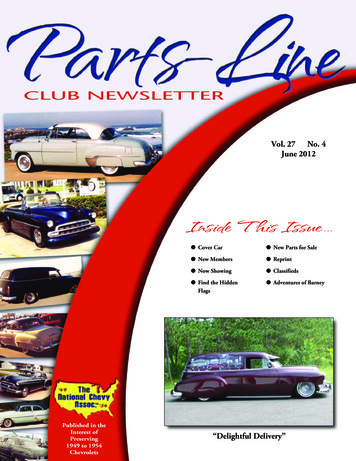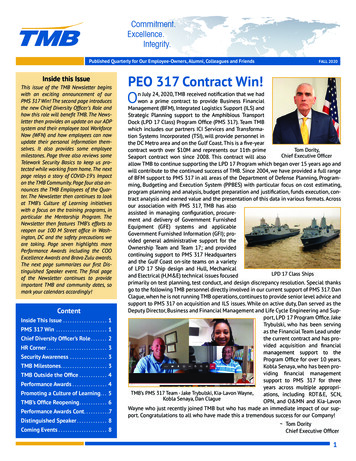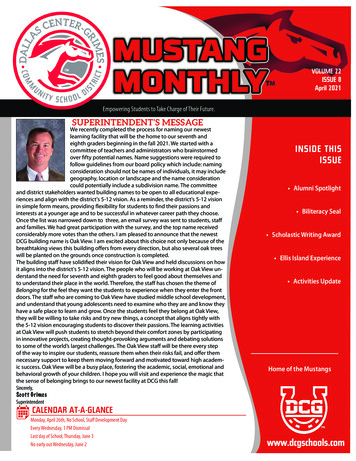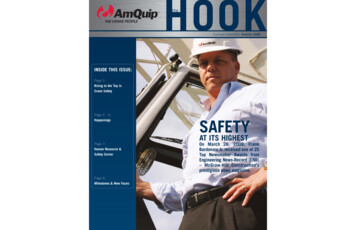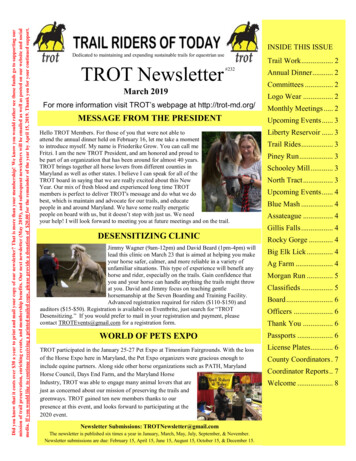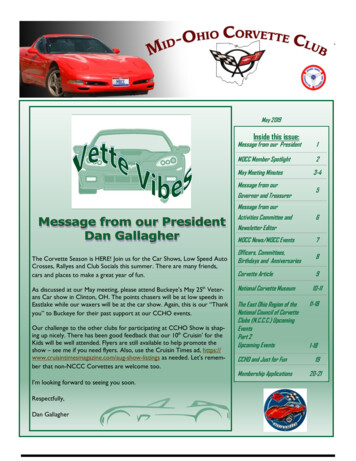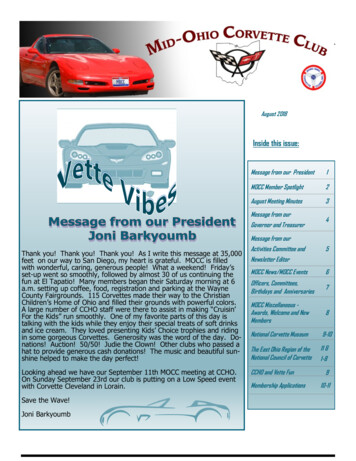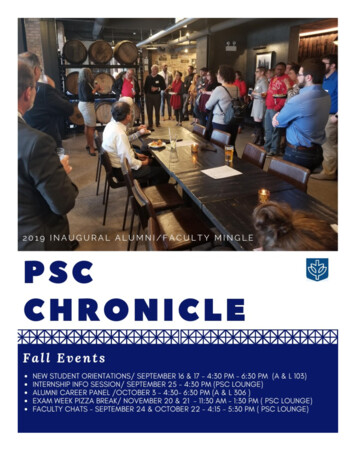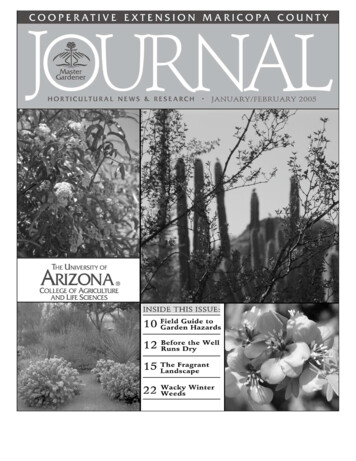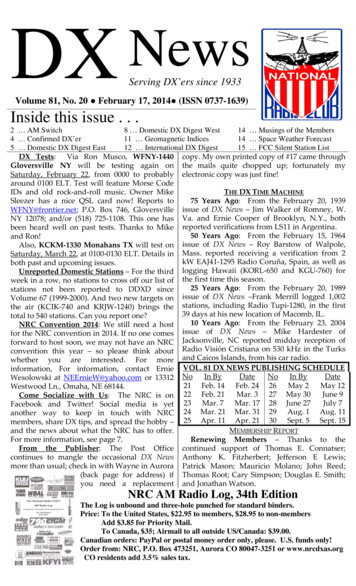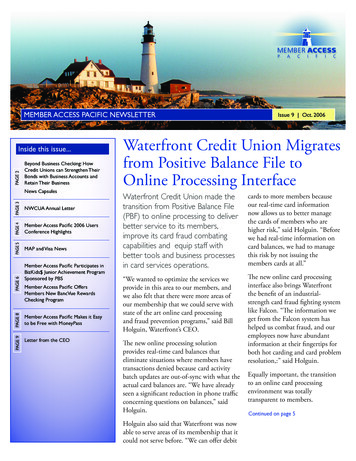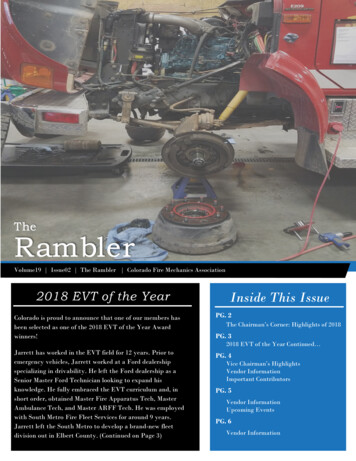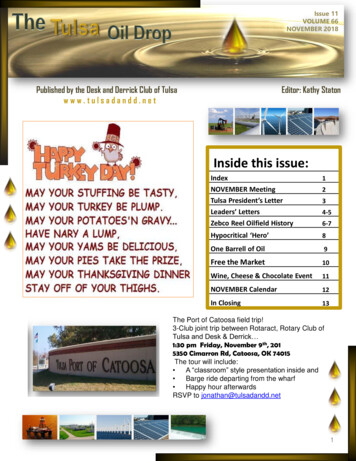
Transcription
Issue 11VOLUME 66NOVEMBER 2018Published by the Desk and Derrick Club of Tulsawww.tulsadandd.netEditor: Kathy StatonInside this issue:IndexNOVEMBER MeetingTulsa President’s LetterLeaders’ LettersZebco Reel Oilfield History1Hypocritical ‘Hero’8One Barrell of Oil9Free the Market10Wine, Cheese & Chocolate Event11NOVEMBER Calendar12In Closing13234-56-7The Port of Catoosa field trip!3-Club joint trip between Rotaract, Rotary Club ofTulsa and Desk & Derrick 1:30 pm Friday, November 9th, 2015350 Cimarron Rd, Catoosa, OK 74015The tour will include: A “classroom” style presentation inside and Barge ride departing from the wharf Happy hour afterwardsRSVP to jonathan@tulsadandd.net1
NOVEMBER 20182
NOVEMBER 2018PRESIDENT’S LETTERNovember 2018Members,As we transition into the fall season, I amreminded of the changes all around us. Thedays are colder, but the trees appear to bewarmer with their orange, red and yellow leaves that eventually form a colorfulblanket on the ground. Sweaters, scarves, and boots are moved to the front ofthe closet, and pantry shelves are stocked with soups and warm beverages inpreparation for the days to come.Just as the seasons change, so do our lives with each new chapter. Familiesgrow and loved ones pass on; an exciting new job begins and then later getsrelocated. There are so many things that can happen – some unexpected, somenot; some that make sense, and others that leave us with so many questions.It is the way we prepare ourselves for change that determines our perspectiveand whether we choose to welcome it or not.My family gave me a mug years ago for Christmas that said “Everythinghappens for a reason just believe!”. By adopting this mindset, we can spendless time dwelling on the past and more time focusing on the future; less timeprocrastinating and more time preparing; less time worrying and more timewelcoming. I hope this helps us all as we go into each new season of life.We are so privileged to have such an experienced and talented speaker thisyear for our Annual Industry Appreciation Luncheon on Wednesday, Nov.14th.Mr. Lee Krystinik, former president of the AAPG, has spoken to thousands ofpeople in the areas of geology and leadership, and will be sharing with us whatis currently happening in the industry and what is yet to come. So, pleasemake every effort to attend and bring your CEO, manager, or anyone else inyour network! You will not want to miss this event!Also in November, we have the opportunity of going to the Port of Catoosa onFriday, Nov. 9th for a tour, a ride on the barge, with a happy hour to follow.Please see more details in this issue of the Tulsa Oil Drop.Sincerely,Dorothy Lenhart, 2018 President3
Leaders’ LettersNOVEMBER 2018NOVEMBER ADDC President's MessageHappy Halloween!The recommendations from a special Ad Hoc committee were approved by the 2018Board and will help us move forward for 2019, with the following changes to the SpecialCommittees list. Special committees will be ADDC Manual Review, Contest, StrategicPlanning Committee (Long Range, Leadership, GAME), Nominating, and Technology.The proposed changes to the Standing Committees will require an amendment to theAssociation Bylaws. Therefore, the 2018 Board will propose to add amendments forthe 2019 B&P Meeting for the following Standing Committees: Club Bylaws Review,Membership, Program, Finance Review Committee, with the new changes consisting ofEducation/Certification, Marketing Committee (Publications, Insight, Social Media,Public Relations/Trade Shows).Research has begun on the outsourcing of the ADO duties, we have submitted RFQsand are waiting to hear back from these companies. Right now, we have heard from 1company. We will keep you updated as information becomes available to us.Thank you all, who took the time to reply back to us on the survey. 414 membersresponded, a third of our membership. There were some key questions, that will helpdrive the board forward by your responses.A special Ad Hoc committee was created to review the outline of conventions.Convention 2021 will be the new first alignment convention, therefore we are looking atthe structure, time, and money of these conventions. With your responses of thesurvey, we will go forward with the option of reducing the days of the convention.The Financial Review committee has begun work as well on the 2018 books. SamThomas and Brian Carter are working on this project. Thank you both!The updated Bylaws for 2019 have been posted on the website. Please ensure youupdate your Club bylaws if needed.Membership renewals have gone out to all club presidents on October 24, 2018.Congratulations to Westbank for being the first to submit their New Club Officers form(ADO31) for 2019. Thank you, Angie. Please ensure to update your information,including your correct email address. This is important, as this is what we use to sendout surveys. We had 20 percent return of bad email addresses. As a reminder, eachmember can log into the website and update their own information. You don’t need towait for someone else to do it. Maybe someone in your club could take on the task ofupdating the website for members.The 2018 Convention made a profit this year, the books are now complete. Thank youto Region II for all their hard work and due diligence. Thank you!Budget and Planning will be January 11-12, 2019 in Tulsa, Oklahoma. Please reachout to a Regional Director, Chairman or Board member for any ideas you may have for2019. We really do want to hear from membership.Wayne has started to email the Region Director and President monthly letters, therebyremoving them from the Insight publication. This should keep the Insight looking moreprofessional and industry related. More like the DDJ was. Hoping this will attractadvertisements as well.Christina Forth4
Leaders’ Letters cont.NOVEMBER 2018Casi NicholsRegion VI Directorregion6rd@yahoo.comWendy SimonButler CountyTammy WatkinsEnidPam HitzGreat BendJamie SabataLiberalThis letter is not available at this time.Michelle BurgardOKCSusan BullardRed EarthDorothy LenhartTulsaAbby BockWichita5
Zebco Reel Oilfield HistoryNOVEMBER 2018When Jasper R. Dell Hull walked into the Tulsa offices of the Zero Hour Bomb Company in1947, he carried a piece of plywood with a few nails in a circle wrapped in line. Attachedwas a coffee-can lid that could spin. Hull, known by his friends as “R.D.,” was an amateurinventor from Rotan, Texas. He had an appointment with executives at the Oklahomaoilfield service company.Since its incorporation in 1932, the Zero Hour Bomb Company had become well known formanufacturing dependable electric timer bombs for fracturing geologic formations. It haddesigned and patented technologies for “shooting” wells to increase oil and natural gasproduction.The company’s timer controlled a mechanism with a detonator in a watertight casing. Thedownhole device could be pre-set to detonate a series of blasting caps, which set off thewell’s main charge, shattering rock formations.Hull’s 1947 visit was timely for Zero Hour Bomb Company, because post World War IIdemand for its electrically triggered devices had declined. With the military no longerneeding oil to fuel the war, the U.S. petroleum industry was in recession. The companyand other once booming Oklahoma service companies were reeling, and the future did notlook good.“Vast fossil fuel reserves beneath other Middle Eastern nations were being unlocked,” notes journalist Joe Sills in a 2014article. “OPEC was beginning to take shape, and Texas and Oklahoma-based domestic oil in the U.S. was about to take adecades-long backseat to foreign oil.”Further, with company patents expiring in 1948, “the Zero Hour Bomb Company needed a solution,” explains Sills, digital editorfor Fishing Tackle Retailer. After examining Hull’s contraption, a prototype fishing reel, the company hired him for 500 a month.Hull later received a patent that would transform Zero Hour Bomb Company – and sport fishing in America.Downhole Patents and a Fishing Reel Beginning in the early 1930s, Zero Hour Bomb engineers patented many innovativeoilfield products. A 1939 design for an “Oil Well Bomb Closure” facilitated assembly of an explosive device capable ofwithstanding extreme pressures submerged deep in a well. A 1940 invention provided a hook mechanism for safely loweringtorpedoes into wells. The locking method was to “positively prevent premature release of the torpedo while it is being loweredinto the well.”Two patents in July1953 for a well bridgewould be among thelast the Zero HourBomb Companyreceived as an oilfieldequipmentmanufacturer, thanksto a fishing reeldesigned by R.D. Hullin the late 1940s andpatented on February2, 1954.Two patents in July 1953 for a well bridge would be among the last the Zero Hour Bomb Company received as an oilfield equipmentmanufacturer, thanks to a fishing reel designed by R.D. Hull in the late 1940s and patented on February 2, 1954.1941 patent improved positioning blasting cartridges with a canvas plugging device that looked like an upside-down umbrella.The “well bridge” automatically opened “when the time bomb or weight reached a position at the bottom of the well.”A 1953 design that took this concept even further would be the last patent Zero Hour Bomb received as an oilfield equipmentmanufacturer. By then, the earliest model of Hull’s new “cannot backlash” reel was attracting crowds at sports shows.6
Zebco Reel Oilfield History (cont.)NOVEMBER 20181941 patent improved positioning blasting cartridges with a canvas plugging device that looked like an upside-downumbrella. The “well bridge” automatically opened “when the time bomb or weight reached a position at the bottom ofthe well.”A 1953 design that took this concept even further would be the last patent Zero Hour Bomb received as an oilfieldequipment manufacturer. By then, the earliest model of Hull’s new “cannot backlash” reel was attracting crowds atsports shows.“After trying to design ‘brakes’ for bait-casting reels, and even failingat launching one fishing reel company, Hull hit on a better way oneday as he watched a grocery store clerk pull string from a large fixedspool to wrap a package,” reports Lee Leschper in a 1999 AmarilloGlobe-News article.Hull realized he needed a cover to keep the line from spinning off thereel itself and soon developed a prototype, Leschper notes. “ZeroHour officials asked two company employees who were avidfishermen for their opinions on the reel. One tied his set of car keysto the end of the line and sent a cast flying through one of thewindows in the plant. The other sent a cast high over the building. Allwere impressed.”Given his own Hull-designed fishing reel at about age six, Leschperrecalls the “tiny black pushbutton reel” came with 6 lb. monofilamentline (a petroleum-based polymer), a four-foot white hollow fiberglassrod, and a hard yellow plastic practice plug.Zero Hour Bomb Company’s first “cannot backlash”reel made its public debut at a Tulsa sports expo inJune 1949.It is even possible the plug was made from Marlex, a revolutionary plastic invented at Phillips Petroleum Company inBartlesville, 45 miles north of Tulsa (see Petroleum Product Hoopla). Leschper adds that “I wore it down to a nubpitching it across the hard-baked grass in our front yard.”Earlier, Hull, had tested several designs before developing a production process; the first reel was produced on May 13,1949. Called the Standard, it made its public debut at a Tulsa sports expo in June. By 1954, the reel’s simple pushbutton system used today was introduced.The regional marketing name – Zebco – became popular, but the bottom of each reel’s foot was stamped with the thename of the manufacturer, Zero Hour Bomb Company. The official name change to Zebco came in 1956, soon after afriend of President Dwight D. Eisenhower asked the company to send a reel to the president.According to a Zebco company history, when White House security officers saw the package labeled “Zero Hour BombCompany,” they plunged it into a tub of water and called the bomb squad. After changing its name to Zebco, thecompany left the oilfield for good.In 1961, Zebco was acquired by Brunswick Corporation and introduced the 202 ZeeBee spincast, “an instant classic.”After shifting reel assembly production to China in 2000, Brunswick a year later sold Zebco to the W.C. BradleyCompany. Zebco headquarters today remains in Tulsa, where it leases a 200,000-square-foot warehouse anddistribution center.Jasper R. Dell “R.D.” Hull was inducted into the Sporting Goods Industry Hall of Fame in 1975 after receiving more than35 patents. At the time of his induction, 70 million Zebco reels had been sold. He retired from the former oilfield timebomb company in January 1977 after being diagnosed with cancer and died in December at age 64.A Zero Hour Bomb Company package addressed to PresidentEisenhower was submerged in water by White House security in 1956.Photo courtesy Fishing Tackle Retailer magazine.7
A Hypocritical “Hero:NOVEMBER 2018Arnold Schwarzenegger is undoubtedly best known forhis legendary heroics on the silver screen. Covered inmud, he survives the Predator – killing it by exploiting itsone weakness. As the Terminator, he protects JohnConnor from a homicidal shape-shifting machine to savehumanity. An unhappy construction worker, he can’tremember who he is, but finally recalls and with his lastbreath saves thousands of lives by releasing air into theMartian atmosphere.Like the character he played in Total Recall, Mr.Schwarzenegger must be having a tough timeremembering who he is – a former Republican Governor.In Austin for the South by Southwest festival, he revealed he has hired a team of California lawyers to sue oil andgas companies for “first degree murder” by “knowingly killing people all over the world.” Instead of acting like aRepublican, Mr. Schwarzenegger must be trying to play the hero again. The only problem is this isn’t the movies,this is real life, and there is nothing to “save” us from.Like many of us, Mr. Schwarzenegger had a long commute to work. After he was elected Governor of California,he decided not to move to the Governor’s Mansion at the state capitol in Sacramento, but in-stead traveled morethan 100 miles for seven years from his mansion in Brentwood, Calif. The only difference: he took a private jet,which cost around 30,000 a roundtrip and impacts the environment about the same amount as a small car doesin three years. And when he’s not taking a private jet to work, he’s driving around in a five-ton,12-mile to thegallon Mercedes or going to lunch in a military-grade Hummer.But now, according to the Governator it’s “absolutely irresponsible” for oil and gas companies to sell theirproducts because they “know [their] product is killing people.” Wait a minute, here. So, it’s okay for oil and gascompanies to sell their products to Mr. Schwarzenegger when he needs to fill up his private jet or Hummer, butit’s not okay for them to sell their products to regular folks so they can drive their vehicles to work? This kind ofdo-as-I-say-not-as-I-do hypocrisy is repulsive and offensive. Mr. Schwarzenegger is not a hero, he’s just anotherelitist Hollywood hypocrite telling you and me how to best live our lives.The real heroes are the oil and gas workers – the landman, the roughneck, the petroleum engineer – who wakeup every day and go to work to support their families and our way of life. Together, these workers produce around10 million barrels of oil and 96 billion cubic feet of natural gas each day that fuel our cars, light our homes, andmake plastics and many other items we use every day. The industry doesn’t just pro-vide the raw materials tomake the things we need – it creates jobs and grows our economy. In 2015, the oil and gas industry supportedmore than 10 million jobs in the United States with an average salary over 100,000 and contributes more than 1 trillion to our economy every year.Despite what Mr. Schwarzenegger may think, the story of energy before oil and gas was simple – most work wasdone by human or animal muscle. This caused the vast majority of the population to live short lives of hard laborin extreme poverty. Before oil and gas were used to power the industrial revolution, the global average lifeexpectancy was only 25 years old with 30 percent of children dying before age 15. During the 1800s, 80 to 90percent of the population of the United States worked in agriculture and spent 74 percent of family income onfood, clothing and shelter. Today, the average person lives more than three times longer than the average personin 1800. This is partly because climate-related deaths, such as starvation or hypothermia, have decreased 98percent in the United States since the use of oil and gas became widespread at the beginning of the 20thCentury.It’s sad – but Mr. Schwarzenegger has gone from superstar hero to Hollywood hypocrite. On the one hand heroutinely uses gas-guzzling jets and cars while on the other he sues oil and gas companies. Given this stunninghypocrisy, I have a question. If oil and gas companies are murderers for selling their ----product, does that makeMr. Schwarzenegger an accessory for being such a good customer?By Railroad Commissioner Wayne Christian03/15/2018Reprinted from Oct. 2018 ADDC 5/2018-09 addc insight.pdf
NOVEMBER 2018Reprinted from Oct. 2018 ADDC /2018-09 addc insight.pdf9
NOVEMBER 2018Free the Market: No Taxpayer Subsidies, No Carbon TaxesBy Railroad Commissioner Wayne Christian07/24/2018Since being sworn-in as our 45th President of the United States, President Donald Trump hasimplemented an America-First energy strategy that has de-fanged an overreaching EPA, endedthe Clean Power Plan, and removed us from the one-sided Paris Climate Accord, whichthreatened our national security, our nation’s energy security and the economic growth thatcomes along with it.As a result, the United States has regained its rightful place as a global energy leader. For thefirst time since 1972, the nation produced more than 10 million barrels of oil per day, and manybelieve we will surpass Saudi Arabia and Russia as the world’s top energy producer in the nextfive years.Regrettably, this progress is under attack. A Republican U.S. Congressman from Florida isattempting to under-mine these hard-fought gains by proposing a carbon-tax on the Americanpeople. This carbon tax would increase the cost of gasoline for American families by more than20 cents per gallon. Much like former President Obama's Clean Power Plan, which would haveincreased the average Texan’s power and gas bills 1,060 annually, a carbon tax is a terrible ideabecause it harms American families and unfairly punishes one form of energy over others.Unfortunately, picking winners and losers in energy is nothing new in our country. For example,the American tax-payer has been on the hook for so-called green energy taxpayer subsidies foryears. In fact, right now, a Texan would receive a 7,500 tax credit from the federal governmentand 2,500 rebate from our own state government to purchase an electric car.This is money out your pocket and mine, going to help wealthy environmentalists buy an 82,000Tesla. That’s roughly 23,000 more than the 59,000 the average family makes in a year in theUnited States. It’s no wonder Elon Musk is the largest recipient of taxpayer subsidies in ournation's history.Boondoggles like Solyndra have highlighted the massive waste within the “green” energymovement. Yet we’ve done little to nothing to stop similar debacles from happening in the future.Inefficient, expensive, and unreliable sources of energy, like wind and solar, continue to receivetaxpayer subsidies over significantly more efficient, affordable, and reliable sources, such asnatural gas. The inequality of these taxpayer subsidies is remarka
Zebco Reel Oilfield History 6-7 Hypocritical ‘Hero’ 8 One Barrell of Oil 9 Free the Market 10 Wine, Cheese & Chocolate Event 11 NOVEMBER Calendar 12 In Closing 13 Published by the Desk and Derrick Club of Tulsa w w w . t u l s a d a n d d . n e t Issue 11 VOLUME 66 NOVEMBER 2018 1 The
